Download RSC III® System - Alpha Research GmbH
Transcript
RSC III® System Reinforced Sternal Closure III® System Application set for reinforcing the conventional closure of the sternum with wires following midline thoracotomy Système complet de renforcement de la fermeture du sternum suite à une thoracotomie médiane Applikationsset zur Verstärkung der konventionellen Drahtosteosynthese des Sternums nach medianer Thorakotomie Sistema Reinforced Sternal Closure III INSTRUCTION MANUAL MANUEL D’INSTRUCTION GEBRAUCHSANWEISUNG 0 4 8 2 Manuale di Istruzioni Reinforced Sternal Closure III® System Description The Reinforced Sternal Closure III® System is a method for reinforcing the conventional wire based closure of the sternum. A highly flexible, cone-shaped reinforcing element transfers the load from the sternal cerclage to a larger area of the sternum, thus preventing the wire from cutting into the cortical layers of the sternum. The complete lining of the bone channel in the sternum with the reinforcing element prevents also bleeding of the spongiosa to a large extent. This hemostatic effect is a further advantage to the conventional procedure. Following midline thoracotomy for heart surgery or thoracic surgery where the sternum is bisected, a major post-operative complication is that of sternal instability. This can arise due to poor quality of the bone and post-operative respiratory movements such as excessive coughing. The most important factor in preventing deep wound complications, chronic osteomyelitis, costal chondritis and mediastinitis is a stable sternal approximation. The Reinforced Sternal Closure III® System enhances significantly sternal stability. The Reinforced Sternal Closure III® System is simple and rapid to use. It consists of wires without a needle, conic reinforcing elements and a single use thorn for the sternal punch. The sternal punch is a resterilizable surgical tool. The conic reinforcing elements, which are placed by the sternal punch directly through the sternum, transfer the load from the sternal cerclage to a larger area of the sternum. This prevents the wire from cutting into the cortical layers of the sternum. This first advantage increases the overall stability of the sternal osteosynthesis significantly. The second advantage is the additional hemostatic effect of the reinforcing element. Indication Patients at high risk of developing sternal instability following midline sternotomy. Absolute Contraindication Known allergy to stainless steel or its components Relative Contraindication Infection or suspected infection in the field of operation. In this case the surgeon must judge the possible advantages against the possible disadvantages or side effects. Possible Side Effects Possible specific side effects of the Reinforced Sternal Closure III® System may include: • • • • • • • Acute and chronic foreign body reaction Allergy through hypersensitisation Chronic infection Injury to chest wall vessels Injury to the heart and/or bypasses Injury to the lung Migration of the reinforcing element Contents and Packaging The RSC III® application set is available in different specifications. Several wires with two reinforcing elements for each wire and one not implantable, single use thorn for the sternal punch are packaged in two sterile tubes and enclosed in an inside sterile peelable bag. Several bags are enclosed in a protective outer product carton. The tubes are closed on both ends with a strap and are transparent in order to identify its content. The Reinforced Sternal Closure III® System fulfils Directive 93/42/EEC of the European Council for Medical Devices. ENG RSC III® System Sterilization Opening the Package The RSC III® application set is sterilized by gamma irradiation. The contents of the bag remain sterile as long as the bag is undamaged, unopened and the directions concerning storage and expiry date are followed. The bag should be peeled open and the sterile contents presented to the user under aseptic conditions. The sterile wires and reinforcing elements are then removed from the tube step by step by the user. Warning: The RSC III® application set cannot be re-sterilized. If the above recommendations are ignored the user is solely liable for any undesirable consequences. Storage The RSC III® application set should be stored in the protective product carton in a cool dry place. Implantation of the RSC III® System First the single use thorn is removed from the tube and then screwed into the RSC® sternal punch. The instrument is opened and a reinforcing element slipped completely over the thorn. Then the sternal punch is placed rectangular to the midline sternotomy line and rectangular to the posterior surface of the sternum (Fig. 1). Fig. 1 Fig. 2 Expiry Date The expiry date of the Reinforced Sternal Closure III® application set is indicated on the label of each product carton and envelope. It should not be used beyond the expiry date. Instructions for the Use of the RSC III® Application Set ENG General Remarks The Reinforced Sternal Closure III® System may only be used by a surgeon. The RSC III® application set was manufactured by Alpha Research with great care and under stringent quality control. Since Alpha Research has no control over the indication and use of the device, Alpha Research cannot give further guarantees for the product. No representative of Alpha Research or distributor of the Reinforced Sternal Closure III® System is entitled to issue any additional guarantees. Warning: General rules pertaining to asepsis must be observed when using the RSC III® application set. The reinforcing elements should only be used with the sternal closure wires supplied with each set. This prevents the possibility of electrocorrosion of either the reinforcing elements or the wires due to different material types. The punch is closed and the reinforcing element pressed into the posterior cortical layer of the sternum. The thorn and the reinforcing element fully penetrate the sternum thus creating the channel for pushing through the corresponding wire at a later step (Fig. 2). The punch is then opened, removed from the body and loaded with the next reinforcing element. Warning: In order to prevent loss in the operation site, the temporary placement of a compress under the sternum half before applying the procedure is recommended. Lost reinforcing elements must be removed as they can lead to uncontrolled damage of structures. The punching and stapling procedure is repeated up to six or eight times at each half of the sternum. The posterior and anterior outlets of the bone channel are marked by the orifices of the reinforcing element. The sternal half is now lifted on one side. The wire is bent rectangular 3 cm from its end, grasped with a needle holder, pushed from posterior to anterior through the reinforcing element orifices and the bone channel. The procedure is repeated at each placed reinforcing element on both corresponding sites thus preparing the single cerclages to be closed (Fig. 3). Fig. 3 Warning: It is important to anchor the reinforcing elements completely into the bone. Partial anchoring at the edge of the sternum in the soft tissue will lead to a failure of the method. ENG After placement of the reinforcing elements and the wires, the wires are twisted together using the conventional technique. The risk of the wires cutting into the posterior and anterior cortical layers of the sternum is reduced by transferring the load from the sternum plates to a larger area of the sternum. Elevated tension can be achieved. This results in a significant increase of the stability of the sternal osteosynthesis. The complete lining of the bone channel with the reinforcing element prevents bleeding from the spongiosa to a large extent. Warning: The RSC® sternal punch is to be closed with both hands under controlled application of pressure. The punching procedure is interrupted immediately after penetrating the ventral cortical layer in order not to crush the sternum und soft tissue. Penetration is to be noticed by a jerk of the RSC® sternal punch. Disposal The redundant reinforcing elements and wire offcuts should be put into a sharps bin for disposal. RSC III® System Reinforced Sternal Closure III® System • Le second avantage est l’effet hémostatique additionnel apporté par la pièce renforçatrice. Description Indications Le Reinforced Sternal Closure III® System (RSC III® System) est une méthode consistant à renforcer la fermeture du sternum tout en utilisant les fils d’acier traditionnels. Une pièce conique de renfort, très flexible, répartit les charges du cerclage sternal à une plus large surface du sternum, évitant ainsi au fil d’acier de cisailler les couches corticales. La totale occupation du passage fait dans l’os sternal par l’élément renforçateur prévient toute extension du saignement de l’os spongieux. Cet effet hémostatique est un avantage supplémentaire apporté à cette procédure conventionnelle. Patients présentant un risque important de développement d’une instabilité sternale, après une sternotomie médiane. Après une chirurgie cardiaque où thoracique par thoracotomie médiane ou le sternum est divisé en deux parties égales, la principale complication post opératoire est l’instabilité sternale. Ce phénomène peut arriver pour cause de mauvaise qualité de l’os sternal ou encore de mouvements respiratoires post opératoire liés à des toux excessives. FR Le plus sûr moyen de prévenir des complications plus sévères telles que l’ostéomyélite chronique, la condrite costale et une médiastinite, est d’assurer une stabilité sternale. Le Reinforced Sternal Closure III® System, en améliorant significativement cette stabilité sternale, remplit cet objectif. Le Reinforced Sternal Closure III® System est simple et rapide à utiliser. L’ensemble est constitué de fils d’acier sans aiguille, d’une pièce conique flexible de renfort et d’une pointe métallique s’installant sur l’agrafeuse sternale. Cette agrafeuse est un outil chirurgical restérilisable. L’élément renforçateur conique qui est placé par l’agrafeuse directement au travers de l’os sternal, permet un transfert des charges du cerclage à une très large partie du sternum. Ceci prévient le cisaillement des couches corticales du sternum par les fils d’acier. • Le premier avantage est l’amélioration significative de l’ostéosynthèse sternale. Contre-indications Absolues Allergie connue à l’acier inoxydable ou à ses composants. Contre-indications Relatives Infection ou suspicion d’infection dans le champ opératoire. Dans ce cas, le chirurgien doit juger des avantages et des inconvénients ainsi que des effets secondaires qui peuvent en résulter. Effets Secondaires Eventuels Les effets secondaires possibles, liés à l’utilisation du RSC III® System peuvent être : • Une réaction aiguë et chronique à tout corps étranger, • Une allergie par hypersensibilisation, • Une infection chronique, • Une lésion des parois des vaisseaux de la poitrine, • Une lésion du muscle cardiaque et/ou des pontages, • Une lésion des poumons, • Une migration de l’élément renforçateur. Presentation Et Emballage Le matériel de pose RSC III® System est disponible sous différentes spécifications. Le système complet se compose de plusieurs fils d’acier avec chacun deux éléments renforçateurs et d’une pointe métallique non implantable se montant sur l’agrafeuse. Les fils d’acier (six ou huit unités disponibles dans trois diamètres différents) sont groupés dans un tube stérile transparent. Les éléments renforçateurs flexibles ainsi que la pointe métallique sont dans un deuxième tube stérile transparent. Chaque tube est fermé aux deux extré- mités par pliage et pincement. Ces deux tubes sont mis ensemble dans un autre emballage stérile pelable. Ces derniers emballages sont au nombre de quatre (pour 4 patients) groupés dans une enveloppe cartonnée protectrice. riel, aucune garantie supplémentaire ne peut être accordée. Aucun représentant d’Alpha Research ou un distributeur du Reinforced Sternal Closure III® System n’est autorisé à donner des garanties additionnelles. Le RSC III® System répond aux exigences de la Directive 93/42 EEC de l’«EUROPEAN COUNCIL FOR MEDICAL DEVICES». Précaution: Les règles générales se rapportant à l’asepsie doivent être respectées lors de l’utilisation du RSC III® System. Le RSC III® System est stérilisé aux Rayons GAMMA. Le contenu de chaque emballage est maintenu stérile à condition que celui-ci n’ait été ni endommagé ni ouvert, et que les conditions de stockage et la date d’expiration soit respectées. Précaution: «Le matériel de pose RSC III» ne peut être restérilisé. Si les recommandations décrites ci-dessus ne sont pas respectées, l’utilisateur est seul responsable de quelconques conséquences indésirables. Stockage L’ensemble de pose RSC III® System doit être entreposé avec son carton protecteur intégral dans un local frais et sec Date d’Expiration La date d’expiration de tout le « matériel de pose » RSC III® System est inscrite sur une étiquette apposée sur chaque emballage et enveloppe cartonnée. Il ne doit pas être utilisé au-delà de cette date. MODE D’EMPLOI POUR L’UTILISATION DU MATERIEL DE POSE RSC III® System Les pièces coniques renforçatrices doivent êtres utilisées essentiellement avec les fils d’acier fournis; ceci pour éviter la possibilité d’électro-corrosion entre les éléments renforçateurs et des fils d’acier de matériau différent. Ouverture De L’emballage L’enveloppe pelable est ouverte afin de libérer son contenu stérile qui doit présenté à l’utilisateur dans des conditions aseptiques. Les fils d’acier et les éléments renforçateurs peuvent alors être retirés du tube l’un après l’autre par l’utilisateur. Implantation Et Utilisation Du RSC III® System Dans un premier temps, la pointe métallique à usage unique doit être ôtée de son tube d’emballage pour être ensuite vissée sur l’agrafeuse. L’instrument est en position relâchée et la pièce renforçatrice conique flexible vient s’adapter et recouvrir complètement la pointe métallique. L’agrafeuse est placée en position rectangulaire à la fois par rapport à la ligne médiane de thoracotomie et la surface postérieure du sternum (Fig.1). Fig. 1 Fig. 2 Remarques Generales Le Reinforced Sternal Closure III® System doit être utilisé uniquement par le chirurgien. Tout le « matériel de pose » RSC III® a été fabriqué par Alpha Research avec le plus grand soin, sous un contrôle qualité rigoureux. Cependant, compte tenu qu’Alpha Research n’a aucun contrôle sur l’indication et l’utilisation du maté- Une pression mécanique sur la poignée de l’agrafeuse permet à la pièce renforçatrice de FR Sterilisation pénétrer l’os sternal par la couche corticale postérieure du sternum. La pointe métallique et la pièce renforçatrice pénètrent totalement l’os sternal créant un passage qui permettra dans une seconde étape d’y pousser le fil d’acier (Fig. 2). En position relâchée, l’agrafeuse est alors retirée de son site opératoire et rechargée avec la pièce renforçatrice suivante. Précaution: Afin d’éviter une perte dans le site opératoire, il est conseillé de placer temporairement une compresse sous la moitié sternale utilisée avant de commencer la procédure. Toute pièce renforçatrice qui aurait pu se détacher doit être éliminée car elle pourrait causer des dommages incontrôlés. L’opération complète est répétée six à huit fois sur chaque moitié sternale. L’entrée postérieure et antérieure du passage effectué dans l’os sternal est marquée par les orifices créés par la pointe métallique et les éléments renforçateurs. Une des deux moitiés sternale est alors levée. FR Le fil d’acier est plié à angle droit à 3 cm de son extrémité, tenu fermement avec un porte aiguille et introduit dans l’orifice postérieur (sens postérieur/antérieur) créé par l’élément renforçateur et poussé dans le passage pratiqué dans l’os sternal. La procédure est répétée à chaque emplacement ou un élément renforçateur a été implanté et chaque site ainsi préparé est prêt pour le serrage définitif (Fig. 3). Fig. 3 Précaution: Il est important que les pièces renforçatrices soient complètement implantées dans la partie osseuse. Un ancrage partiel sur le bord du sternum dans les tissus mous peut limiter l’efficacité ou conduire à l’échec de la méthode. Après placement et positionnement des éléments renforçateurs et des fils d’acier, ceux-ci sont torsadés ensemble en utilisant une technique conventionnelle. Le risque que les fils d’acier cisaillent les couches corticales postérieures et antérieures du sternum est limité pour l’unique raison que la répartition des charges se fait sur une plus large surface du sternum. Parallèlement, une tension supérieure peut être appliquée. Le résultat est un accroissement de la stabilité de l’ostéosynthèse sternale. De plus, l’insertion complète de l’élément renforçateur dans la partie osseuse du sternum limite considérablement le saignement de cet os spongieux. Précaution: L’agrafeuse est faite pour être fermée avec les deux mains tout en contrôlant la pression exercée. La procédure d’insertion doit être interrompue dès que la couche corticale ventrale est atteinte et ceci afin d’éviter de comprimer l’os et les tissus mous. L’utilisateur sait que la pénétration idéale est atteinte par la sensation d’un temps d’arrêt lors de la pression exercée sur la poignée de l’agrafeuse et par un léger bruit caractéristique. Mise Au Rebut Les éléments renforçateurs restants et les parties coupées des fils d’acier seront placés dans des boîtes à déchets spéciales pour destruction. Reinforced Sternal Closure III® System Beschreibung Das Reinforced Sternal Closure III® System ist eine Methode um den konventionellen Verschluss des Sternums zu verstärken. Ein hoch flexibles konisches Verstärkungselement überträgt die mechanische Belastung der Sternumcerclage auf eine größere Auflagefläche im Sternum und verhindert dadurch das Einschneiden der Drähte in die Kortikalis des Sternums. Die vollständige Auskleidung des Stichkanals im Sternum durch das Verstärkungselement verhindert weitgehend eine Blutung aus der Spongiosa. Dieser hämostatische Effekt ist ein weiterer Vorteil zum konventionellen Verfahren. Nach herz- oder thoraxchirurgischen Eingriffen mit medianer Sternotomie ist die Instabilität des Sternums eine bedeutende postoperative Komplikation. Die Ursachen dafür können eine verminderte Qualität der Knochenmatrix oder heftige Hustenstöße postoperativ sein. Eine stabile Osteosynthese des Sternums ist eine Grundvoraussetzung zur Vorbeugung von chronischer Osteomyelitis, Chondritis der Rippen, Mediastinitis und anderen Komplikationen des tiefen Wundbereichs. Das Reinforced Sternal Closure III® erhöht signifikant die Stabilität der sternalen Osteosynthese. Das Reinforced Sternal Closure III System ist schnell und einfach anzuwenden. Es besteht aus Cerclagedrähten ohne Nadel, konischen Verstärkungselementen und einem für den Einmalgebrauch bestimmten Dorn für die RSC® Stanze. Die Sternumstanze ist ein resterilisierbares chirurgisches Instrument. Die konischen Verstärkungselemente, welche direkt mit der Sternumstanze ins Sternum appliziert werden, übertragen die mechanische Belastung der Sternumcerclage auf eine größere Auflagefläche der Sternumplatten. Dadurch wird das Einschneiden der Drähte in die Kortikalis des Sternums verhindert. Dieser Vorteil erhöht signifikant die Gesamtstabilität der sternalen Osteosynthese. Ein weiterer Vorteil zum konventionellen Verfahren ist der zusätzliche hämostatische Effekt des Verstärkungselements. ® Indikation Patienten, die nach medianer Thorakotomie ein erhöhtes Risiko für die Entwicklung einer Sternuminstabilität aufweisen. Absolute Kontraindikation Bekannte Allergien gegen rostfreien Stahl oder gegen einzelne Komponenten Relative Kontraindikation Infektionen oder Verdacht auf Infektionen im Operationsgebiet. In diesem Fall sollte eine Anwendung nur unter strenger Indikationsstellung und Risikoerwägung erfolgen. Mögliche Nebenwirkungen Mögliche spezifische Nebenwirkungen des Reinforced Sternal Closure III® Systems können sein: • Akute oder chronische Fremdkörperreaktionen • Allergie durch Sensibilisierung • Chronische Infektionen • Verletzungen von Gefäßen der Brustwand • Verletzungen des Herzens und/oder der Bypässe • Verletzungen der Lunge • Migration des Verstärkungselements Inhalt und Verpackung Das RSC III® Applikationsset ist in verschiedenen Spezifikationen erhältlich. Mehrere Drähte mit je 2 Verstärkungselementen pro Draht und ein nicht implantierbarer, für den Einmalgebrauch bestimmter Dorn für die Sternumstanze, befinden sich in zwei sterilen Rohren, die von einem innen sterilen Peelbeutel umhüllt werden. Mehrere Beutel sind im schützenden Produktkarton enthalten. Die Rohre sind an ihren Enden mit Laschen verschlossen und transparent, so dass der Inhalt sichtbar ist. Das Reinforced Sternal Closure III® System erfüllt die Direktive 93/42/EEC des Europäischen Rates für Medizinprodukte. DEU RSC III® System Sterilisation Das RSC III® Applikationsset ist mit Gammastrahlen sterilisiert. Der Inhalt des Beutels ist steril, sofern der Beutel unversehrt, ungeöffnet und vorschriftsmäßig gelagert wurde und das Verfallsdatum nicht überschritten ist. den. Dadurch wird eine mögliche Elektrokorrosion der Verstärkungselemente oder Drähte wegen unterschiedlichen Materials verhindert. Öffnen der Verpackung Warnhinweis: Das RSC III Applikationsset kann nicht resterilisiert werden. Bei Nichtbefolgen der Empfehlungen ist der Anwender für unerwünschte Folgen allein verantwortlich. Der Peelbeutel wird geöffnet und der Inhalt aseptisch angereicht. Die sterilen Drähte und Verstärkungselemente werden dann durch den Anwender schrittweise aus den Rohren entnommen. Lagerung Implantation des RSC III® Systems Das RSC III® Applikationsset soll im schützenden Produktkarton kühl und trocken gelagert werden. Der zum Einmalgebrauch bestimmte Dorn wird aus dem entsprechenden Rohr entnommen und in die RSC® Sternumstanze eingeschraubt. Das Instrument wird geöffnet und ein Verstärkungselement vollständig über den Dorn gezogen. Dann wird die Sternumstanze rechtwinklig zur Sternotomiemittellinie und rechtwinklig zur posterioren Oberfläche des Sternums angesetzt (Fig. 1). ® Verfallsdatum Das Verfallsdatum befindet sich auf dem Aufkleber von jedem Produktkarton und Peelbeutel. Eine Verwendung über das Verfallsdatum hinaus ist nicht zulässig. Fig. 1 Fig. 2 Hinweise zum Gebrauch des RSC III® Applikationssets Allgemeine Hinweise DEU Das Reinforced Sternal Closure III® System darf nur durch einen Chirurgen implantiert werden. Das RSC III® Applikationsset wurde von Alpha Research mit großer Sorgfalt und unter strenger Qualitätskontrolle hergestellt. Da Alpha Research keine Kontrolle über die Indikation und den Gebrauch des Produkts hat, kann Alpha Research keine weitergehenden Garantien für die Ware übernehmen. Weder die Mitarbeiter von Alpha Research noch Vertriebs partner sind berechtigt, in irgendeiner Form weitergehende Garantiererklärungen abzugeben. Warnhinweis: Die allgemeinen Regeln der Asepsis müssen bei der Verwendung des RSC III® Applikationssets beachtet werden. Die Verstärkungselemente dürfen nur mit den im Set beigelegten Sternumdrähten verwendet wer- 10 Die Sternumstanze wird bis zum Anschlag geschlossen und das Verstärkungselement wird in die posteriore Kortikalis des Sternums eingepresst. Dorn und Verstärkungselement penetrieren das Sternum vollständig. Es bildet sich so der mit dem Verstärkungselement ausgekleidete Kanal für das Vorschieben des Drahtes in einem späteren Schritt (Fig. 2). Die Stanze wird dann geöffnet, aus dem Situs entfernt und der Dorn mit dem nächsten Verstärkungselement bestückt. Warnhinweis: Das temporäre Unterlegen einer Kompresse unter die Sternumhälfte vor der Prozedur wird empfohlen, um einen Verlust des Verstärkungselements im Operationssitus zu vermeiden. Verlorene Verstärkungsele- mente müssen entfernt werden, da sie zu unkontrollierten Schäden von Strukturen führen können. kanals durch das Verstärkungselement verhindert zudem weitgehend eine Blutung aus der Spongiosa. Der Stanzvorgang wird 6-8mal in jeder Sternumhälfte wiederholt. Der posteriore und anteriore Eingang des Knochenkanals sind durch die Öffnungen in dem Verstärkungselement gekennzeichnet. Die Sternumhälfte wird nun an einer Seite angehoben. Der Draht wird 3 cm vom Ende entfernt rechtwinklig gebogen und mit dem Nadelhalter gefasst. Der Draht wird von posterior nach anterior durch die Öffnungen des Verstärkungselements durch den Knochenkanal geschoben. Der Vorgang wird bei jedem platzierten Verstärkungselement auf beiden Seiten wiederholt. Damit werden die Sternumcerclagen für den Verschluss vorgelegt (Fig. 3). Warnhinweis: Nach dem Ansetzen der Stanze ist diese mit beiden Händen unter kontrolliertem Krafteinsatz zu schließen. Der Stanzvorgang ist unmittelbar nach dem Durchdringen der ventralen Kortikalis, welches durch einen Ruck der Stanze zu bemerken ist, zu beenden, da sonst Sternum und Weichteilstrukturen zerquetscht werden können. Entsorgung Die Drahtreste und überzählige Verstärkungselemente sollen in einem Einweg-Entsorgungsbehälter entsorgt werden. DEU Fig. 3 Warnhinweis: Es ist wichtig, das Verstärkungselement vollständig im Knochen zu verankern. Partielles Verankern des Verstärkungselements am Sternumrand im Weichteilgewebe führt zu einem Versagen der Methode. Nachdem die Verstärkungselemente und Drähte vorgelegt sind, werden die Drähte in herkömmlicher Weise verdrillt. Durch die größere Auflagefläche wird das Risiko des Einschneidens der Drähte in die posteriore und anteriore Kortikalis des Sternums vermindert. Dadurch wird eine höhere Spannung als normal erreicht, was zu einer gesamthaft gesehen signifikant höheren Stabilität der sternalen Osteosynthese führt. Das vollständige Ausfüllen des Stich- 11 Sistema RSC III® Sistema Reinforced Sternal Closure III® Descrizione Il sistema Reinforced Sternal Closure III® è un metodo per rinforzare la tecnica convenzionale di chiusura dello sterno con il filo. Un elemento di rinforzo altamente flessibile, di forma conica, trasferisce il carico dal cerchiaggio dello sterno ad una zona più ampia dello stesso, impedendo così al filo di incidere gli strati corticali dello sterno. Rivestendo completamente il canale osseo dello sterno con l’elemento di rinforzo, inoltre, si impedisce in gran parte il sanguinamento della sostanza spugnosa. L’effetto emostatico è un ulteriore vantaggio rispetto alla procedura convenzionale. La complicazione postoperatoria principale dopo le toracotomie (sternotomie mediane), usate in chirurgia cardiaca o toracica e nelle quali lo sterno viene tagliato in due, è quella della stabilità sternale. Tale complicazione può essere causata dal cattivo stato delle ossa o dai movimenti respiratori postoperatori quali l’eccessiva tosse. Il fattore più importante per prevenire complicazioni da ferite profonde, osteomielite cronica, condrite costale e mediastiniti è un accostamento stabile delle due parti dello sterno. Il sistema Reinforced Sternal Closure III® aumenta significativamente la stabilità dello sterno. ITA Il sistema Reinforced Sternal Closure III® è facile e veloce da usare. Il sistema consiste di fili, senza aghi, elementi di rinforzo conici e una spina monouso per il punzone sternale. Il punzone sternale è un apparecchio chirurgico risterilizzabile. Gli elementi di rinforzo conici vengono inseriti per mezzo del punzone sternale direttamente attraverso lo sterno, trasferendo così il carico dal cerchiaggio dello sterno ad una zona più ampia dello stesso. Ciò impedisce al filo di incidere gli strati corticali dello sterno. Il primo vantaggio di questa tecnica è che aumenta di molto la stabilità dell’osteosintesi sternale. Il secondo vantaggio è l’effetto emostatico aggiuntivo dell’elemento di rinforzo. 12 Indicazioni Pazienti ad alto rischio di sviluppo di instabilità sternale a seguito di sternotomia mediana. Controindicazioni assolute Allergia nota all’acciaio inossidabile o ai suoi componenti Controindicazioni relative Infezione certa o sospetto di infezione nel campo operatorio. In questo caso il chirurgo deve valutare i possibili vantaggi e svantaggi e gli effetti collaterali. Possibili Effetti Collaterali I possibili effetti collaterali del Sistema Reinforced Sternal Closure III® possono comprendere: • Reazioni acute e croniche alla presenza di corpi esterni • Allergia conseguente all’ipersensibilizzazione • Infezione cronica • Lesioni ai vasi della parete toracica • Lesioni al cuore e/o ai bypass • Lesioni polmonari • Migrazione degli elementi di rinforzo all’interno del corpo Contenuto dell’imballaggio Il set RSC III® è disponibile in diversi formati. Diversi fili, ciascuno con due elementi di rinforzo, sono chiusi insieme ad una spina monouso per il punzone sternale in due tubi sterili a loro volta chiusi in una busta strappabile sterilizzata internamente. Diverse buste di questo tipo sono poi chiuse in una scatola protettiva in cartone. I tubi sono chiusi da tutte e due le parti da una cinghietta rimuovibile e sono trasparenti per permettere l’identificazione del contenuto. Il sistema Reinforced Sternal Closure III® è conforme alla Direttiva 93/42/EEC del Consiglio d’Europa per le apparecchiature mediche. Sterilizzazione Apertura dell’imballaggio Il set RSC III® è sterilizzato con raggi gamma. I contenuti del sacchetto rimangono sterili fintanto che il sacchetto rimane chiuso e integro e vengono rispettate le istruzioni di conservazione e la data di scadenza. Il sacchetto va aperto strappandolo e il suo contenuto, sterile, deve essere consegnato all’utilizzatore in condizioni asettiche. L’utilizzatore dovrà quindi provvedere ad estrarre i fili sterili e gli elementi di rinforzo dal tubo gradualmente. Attenzione: Il set RSC III® non può essere sterilizzato di nuovo. Se le istruzioni di cui sopra vengono ignorate la responsabilità per eventuali conseguenze indesiderate è interamente dell’utente. Conservazione Il set RSC III® deve essere conservato chiuso nell’apposita scatola, in luogo fresco e asciutto. Impianto del Sistema RSC III® Innanzitutto rimuovete la spina monouso dal tubo e avvitatela sul punzone sternale RSC®. Aprite poi lo strumento e infilate un elemento di rinforzo sopra la spina. Posizionate quindi il punzone sternale perpendicolarmente alla linea di mezzo della sternotomia e perpendicolare alla superficie posteriore dello sterno come indicato in (Fig. 1). Fig. 1 Fig. 2 Data di scadenza La data di scadenza per il set Reinforced Sternal Closure III® è riportata sull’etichetta di ciascuna scatola e sacchetto. Non utilizzare successivamente alla data di scadenza. Note generali Il sistema Reinforced Sternal Closure III® deve essere usato solo da chirurghi. Il set RSC III® è stato costruito da Alpha Research con grande attenzione e secondo rigidi criteri di controllo qualità. Poiché Alpha Research non ha alcun controllo sull’uso e le indicazioni del prodotto, non è possibile dare ulteriori garanzie in merito. I rappresentanti e i distributori del sistema Reinforced Sternal Closure III® non sono autorizzati a dare ulteriori garanzie in merito. Attenzione: I generici accorgimenti in merito all’asetticità sono da osservare nell’uso del set RSC III®. Gli elementi di rinforzo devono essere utilizzati solo con i fili per la chiusura dello sterno contenuti in ciascun set. Ciò previene il rischio di elettrocorrosione degli elementi di rinforzo o dei fili a causa dell’uso di materiali di tipo diverso. Chiudete il punzone e l’elemento di rinforzo viene premuto nello strato corticale posteriore dello sterno. L’elemento di rinforzo e la spina penetrano nello sterno completamente e creano il canale per far passare il filo corrispondente in seguito (Fig. 2). Ora aprite il punzone, toglietelo dal corpo e caricatelo con il successivo elemento di rinforzo. Attenzione: Al fine di prevenire perdite all’interno del campo operatorio, si raccomanda, prima di procedere all’applicazione, di porre una compressa di garza sotto la metà dello sterno. Eventuali elementi di rinforzo che vengano smarriti devono essere rimossi per evitare danni incontrollati al corpo. La procedura di punzonatura e cucitura va ripetuta fino a sei o otto volte per ogni metà dello sterno. Le estremità anteriore e posteriore del canale osseo sono contrassegnate dagli orifici dell’elemento di rinforzo. A questo punto la metà dello sterno risulta sollevata su un 13 ITA Istruzioni per l’uso del Set RSC III® lato. Piegate ora il filo perpendicolarmente per una lunghezza di 3 cm dal termine, afferratelo con un portaaghi, spingetelo dall’estremità posteriore a quella anteriore attraverso gli orifizi degli elementi di rinforzo e attraverso il canale osseo. Ripetete la procedura per ogni coppia di elementi di rinforzo, così da preparare i cerchiaggi che dovranno poi essere chiusi (Fig. 3). Fig. 3 ITA Attenzione: È importante che gli elementi di rinforzo siano completamente fissati nell’osso. Qualora essi al contrario siano fissati solo parzialmente sul bordo dello sterno nel tessuto morbido la procedura è destinata a fallire. Dopo aver piazzato i fili e gli elementi di rinforzo intrecciate i fili con la tecnica convenzionale. Il rischio che i fili incidano gli strati corticali anteriori e posteriori dello sterno viene ridotto grazie al trasferimento del carico dalle piastre dello sterno ad una zona più ampia dello stesso. Così facendo è possibile raggiungere una tensione molto elevata. In tal modo si aumenta di molto la stabilità dell’osteosintesi sternale. Rivestendo completamente il canale osseo dello sterno con l’elemento di rinforzo si impedisce anche, in gran parte, il sanguinamento della sostanza spugnosa. Attenzione: Il punzone sternale RSC® deve essere chiuso saldamente con tutte e due le mani controllando la pressione applicata. La procedura di punzonatura va interrotta immediatamente in caso di penetrazione dello strato corticale ventrale onde evitare di frantumare 14 lo sterno ed il tessuto molle. L’avvenuta penetrazione è indicata da uno scatto del punzone sternale RSC®. Smaltimento rifiuti Gli elementi di rinforzo non utilizzati e i frammenti di filo tagliati vanno riposti in contenitori per materiali taglienti per il successivo smaltimento. Manufactured by Alpha Research Deutschland GmbH Goslarer Platz 7 10589 Berlin Germany E-Mail: [email protected] Website: www.alpha-research.com Date of issue: 08/2005 Copyright© 2005 0 4 8 2
















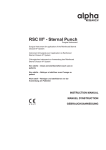


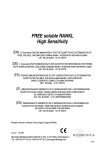

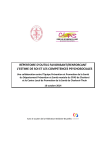
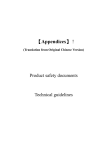

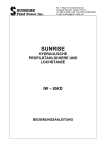
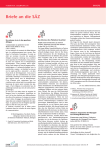
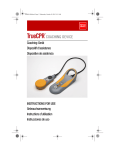
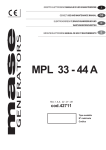

![CPC REGIONALES [TOURS]](http://vs1.manualzilla.com/store/data/006508649_1-05ecd0188d6b32435380f1a967179b3d-150x150.png)